Ting-Chun Wang
Cosmos-Transfer1: Conditional World Generation with Adaptive Multimodal Control
Mar 18, 2025Abstract:We introduce Cosmos-Transfer, a conditional world generation model that can generate world simulations based on multiple spatial control inputs of various modalities such as segmentation, depth, and edge. In the design, the spatial conditional scheme is adaptive and customizable. It allows weighting different conditional inputs differently at different spatial locations. This enables highly controllable world generation and finds use in various world-to-world transfer use cases, including Sim2Real. We conduct extensive evaluations to analyze the proposed model and demonstrate its applications for Physical AI, including robotics Sim2Real and autonomous vehicle data enrichment. We further demonstrate an inference scaling strategy to achieve real-time world generation with an NVIDIA GB200 NVL72 rack. To help accelerate research development in the field, we open-source our models and code at https://github.com/nvidia-cosmos/cosmos-transfer1.
Cosmos World Foundation Model Platform for Physical AI
Jan 07, 2025



Abstract:Physical AI needs to be trained digitally first. It needs a digital twin of itself, the policy model, and a digital twin of the world, the world model. In this paper, we present the Cosmos World Foundation Model Platform to help developers build customized world models for their Physical AI setups. We position a world foundation model as a general-purpose world model that can be fine-tuned into customized world models for downstream applications. Our platform covers a video curation pipeline, pre-trained world foundation models, examples of post-training of pre-trained world foundation models, and video tokenizers. To help Physical AI builders solve the most critical problems of our society, we make our platform open-source and our models open-weight with permissive licenses available via https://github.com/NVIDIA/Cosmos.
Edify Image: High-Quality Image Generation with Pixel Space Laplacian Diffusion Models
Nov 11, 2024Abstract:We introduce Edify Image, a family of diffusion models capable of generating photorealistic image content with pixel-perfect accuracy. Edify Image utilizes cascaded pixel-space diffusion models trained using a novel Laplacian diffusion process, in which image signals at different frequency bands are attenuated at varying rates. Edify Image supports a wide range of applications, including text-to-image synthesis, 4K upsampling, ControlNets, 360 HDR panorama generation, and finetuning for image customization.
JeDi: Joint-Image Diffusion Models for Finetuning-Free Personalized Text-to-Image Generation
Jul 08, 2024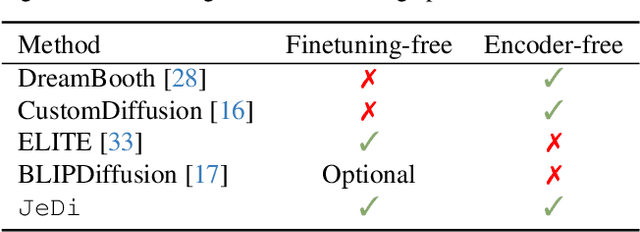
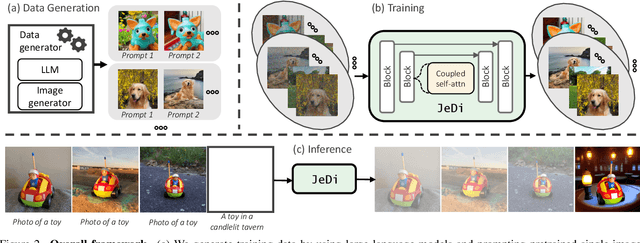

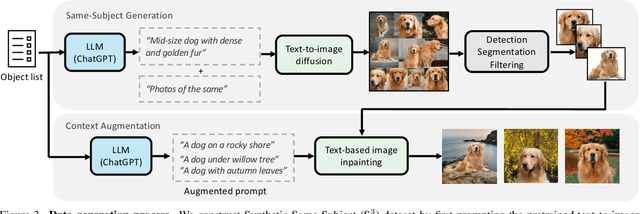
Abstract:Personalized text-to-image generation models enable users to create images that depict their individual possessions in diverse scenes, finding applications in various domains. To achieve the personalization capability, existing methods rely on finetuning a text-to-image foundation model on a user's custom dataset, which can be non-trivial for general users, resource-intensive, and time-consuming. Despite attempts to develop finetuning-free methods, their generation quality is much lower compared to their finetuning counterparts. In this paper, we propose Joint-Image Diffusion (\jedi), an effective technique for learning a finetuning-free personalization model. Our key idea is to learn the joint distribution of multiple related text-image pairs that share a common subject. To facilitate learning, we propose a scalable synthetic dataset generation technique. Once trained, our model enables fast and easy personalization at test time by simply using reference images as input during the sampling process. Our approach does not require any expensive optimization process or additional modules and can faithfully preserve the identity represented by any number of reference images. Experimental results show that our model achieves state-of-the-art generation quality, both quantitatively and qualitatively, significantly outperforming both the prior finetuning-based and finetuning-free personalization baselines.
DreamPose: Fashion Image-to-Video Synthesis via Stable Diffusion
May 04, 2023Abstract:We present DreamPose, a diffusion-based method for generating animated fashion videos from still images. Given an image and a sequence of human body poses, our method synthesizes a video containing both human and fabric motion. To achieve this, we transform a pretrained text-to-image model (Stable Diffusion) into a pose-and-image guided video synthesis model, using a novel finetuning strategy, a set of architectural changes to support the added conditioning signals, and techniques to encourage temporal consistency. We fine-tune on a collection of fashion videos from the UBC Fashion dataset. We evaluate our method on a variety of clothing styles and poses, and demonstrate that our method produces state-of-the-art results on fashion video animation. Video results are available on our project page.
SPACE: Speech-driven Portrait Animation with Controllable Expression
Dec 07, 2022
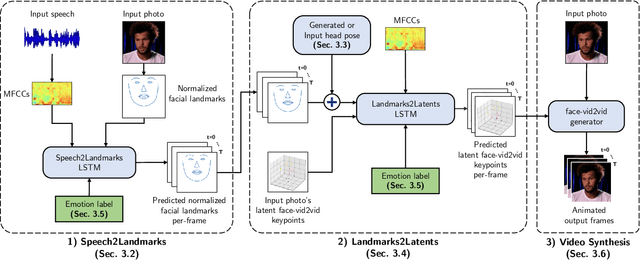
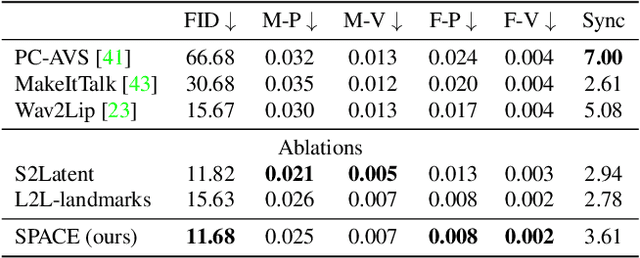

Abstract:Animating portraits using speech has received growing attention in recent years, with various creative and practical use cases. An ideal generated video should have good lip sync with the audio, natural facial expressions and head motions, and high frame quality. In this work, we present SPACE, which uses speech and a single image to generate high-resolution, and expressive videos with realistic head pose, without requiring a driving video. It uses a multi-stage approach, combining the controllability of facial landmarks with the high-quality synthesis power of a pretrained face generator. SPACE also allows for the control of emotions and their intensities. Our method outperforms prior methods in objective metrics for image quality and facial motions and is strongly preferred by users in pair-wise comparisons. The project website is available at https://deepimagination.cc/SPACE/
Implicit Warping for Animation with Image Sets
Oct 04, 2022
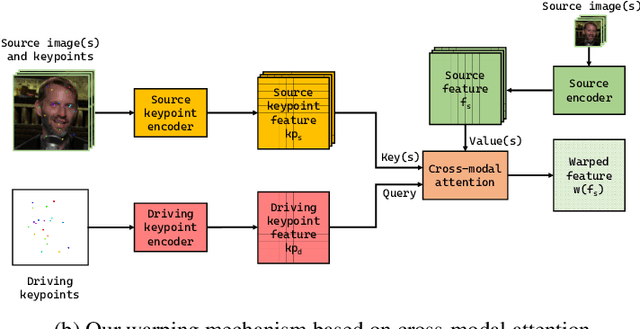
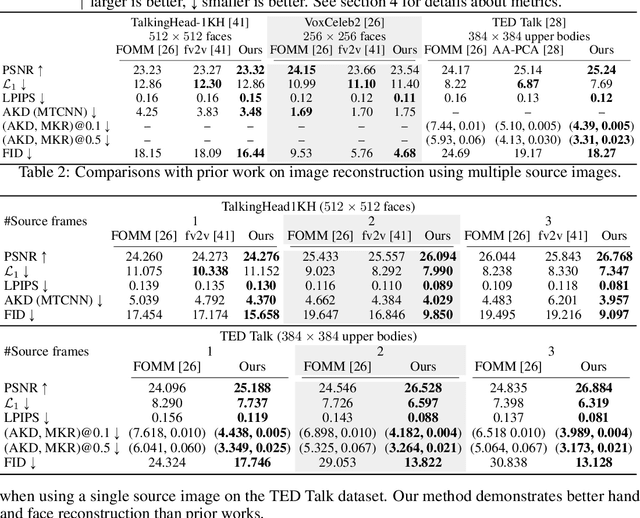
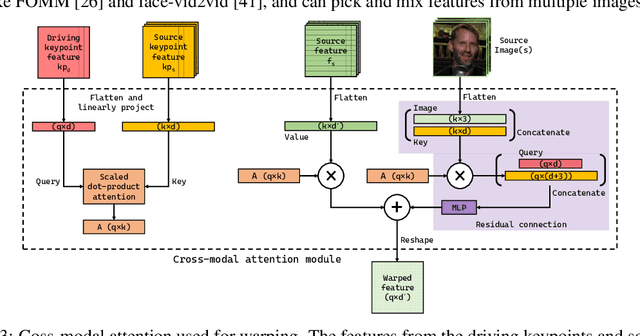
Abstract:We present a new implicit warping framework for image animation using sets of source images through the transfer of the motion of a driving video. A single cross- modal attention layer is used to find correspondences between the source images and the driving image, choose the most appropriate features from different source images, and warp the selected features. This is in contrast to the existing methods that use explicit flow-based warping, which is designed for animation using a single source and does not extend well to multiple sources. The pick-and-choose capability of our framework helps it achieve state-of-the-art results on multiple datasets for image animation using both single and multiple source images. The project website is available at https://deepimagination.cc/implicit warping/
Learning to Relight Portrait Images via a Virtual Light Stage and Synthetic-to-Real Adaptation
Sep 21, 2022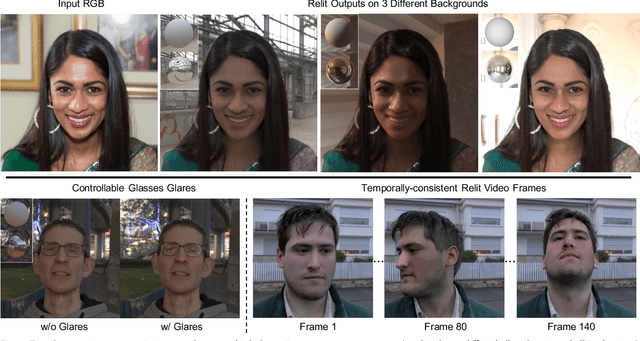

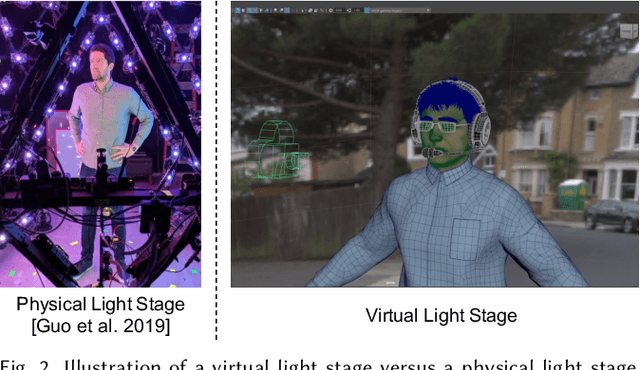
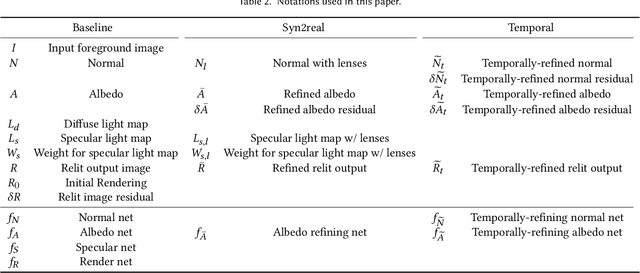
Abstract:Given a portrait image of a person and an environment map of the target lighting, portrait relighting aims to re-illuminate the person in the image as if the person appeared in an environment with the target lighting. To achieve high-quality results, recent methods rely on deep learning. An effective approach is to supervise the training of deep neural networks with a high-fidelity dataset of desired input-output pairs, captured with a light stage. However, acquiring such data requires an expensive special capture rig and time-consuming efforts, limiting access to only a few resourceful laboratories. To address the limitation, we propose a new approach that can perform on par with the state-of-the-art (SOTA) relighting methods without requiring a light stage. Our approach is based on the realization that a successful relighting of a portrait image depends on two conditions. First, the method needs to mimic the behaviors of physically-based relighting. Second, the output has to be photorealistic. To meet the first condition, we propose to train the relighting network with training data generated by a virtual light stage that performs physically-based rendering on various 3D synthetic humans under different environment maps. To meet the second condition, we develop a novel synthetic-to-real approach to bring photorealism to the relighting network output. In addition to achieving SOTA results, our approach offers several advantages over the prior methods, including controllable glares on glasses and more temporally-consistent results for relighting videos.
* To appear in ACM Transactions on Graphics (SIGGRAPH Asia 2022). 21 pages, 25 figures, 7 tables. Project page: https://deepimagination.cc/Lumos/
Generating Long Videos of Dynamic Scenes
Jun 09, 2022



Abstract:We present a video generation model that accurately reproduces object motion, changes in camera viewpoint, and new content that arises over time. Existing video generation methods often fail to produce new content as a function of time while maintaining consistencies expected in real environments, such as plausible dynamics and object persistence. A common failure case is for content to never change due to over-reliance on inductive biases to provide temporal consistency, such as a single latent code that dictates content for the entire video. On the other extreme, without long-term consistency, generated videos may morph unrealistically between different scenes. To address these limitations, we prioritize the time axis by redesigning the temporal latent representation and learning long-term consistency from data by training on longer videos. To this end, we leverage a two-phase training strategy, where we separately train using longer videos at a low resolution and shorter videos at a high resolution. To evaluate the capabilities of our model, we introduce two new benchmark datasets with explicit focus on long-term temporal dynamics.
BARCOR: Towards A Unified Framework for Conversational Recommendation Systems
Mar 27, 2022



Abstract:Recommendation systems focus on helping users find items of interest in the situations of information overload, where users' preferences are typically estimated by the past observed behaviors. In contrast, conversational recommendation systems (CRS) aim to understand users' preferences via interactions in conversation flows. CRS is a complex problem that consists of two main tasks: (1) recommendation and (2) response generation. Previous work often tried to solve the problem in a modular manner, where recommenders and response generators are separate neural models. Such modular architectures often come with a complicated and unintuitive connection between the modules, leading to inefficient learning and other issues. In this work, we propose a unified framework based on BART for conversational recommendation, which tackles two tasks in a single model. Furthermore, we also design and collect a lightweight knowledge graph for CRS in the movie domain. The experimental results show that the proposed methods achieve the state-of-the-art performance in terms of both automatic and human evaluation.
 Add to Chrome
Add to Chrome Add to Firefox
Add to Firefox Add to Edge
Add to Edge